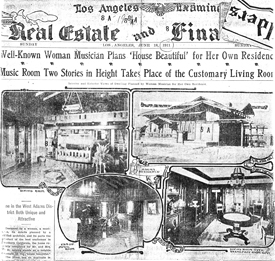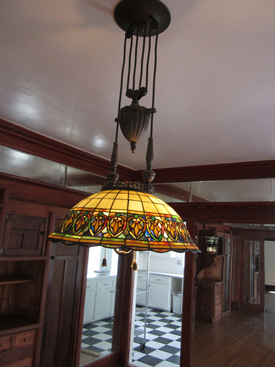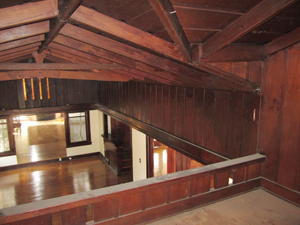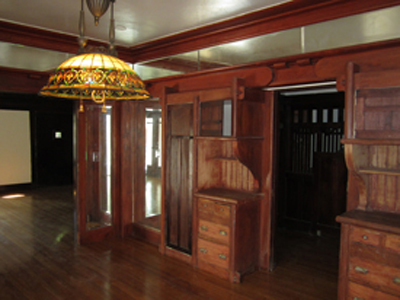Restoring An Architectural Treasure
- Details
- Category: Architecture
- Published on Monday, 12 October 2015 13:58
- Written by Renee Montgomery
 In 1911, upon the completion of the magnificent home at 2508 9th Avenue, the Los Angeles Herald Examiner referred to it as "House beautiful . . . no duplicate in Southern California". Custom designed in an impressive “high” Arts-and-Crafts style by the renowned Heineman architectural firm for Mr. and Mrs. R.H. Adams, the house is now being readied for sale by the current owner.
In 1911, upon the completion of the magnificent home at 2508 9th Avenue, the Los Angeles Herald Examiner referred to it as "House beautiful . . . no duplicate in Southern California". Custom designed in an impressive “high” Arts-and-Crafts style by the renowned Heineman architectural firm for Mr. and Mrs. R.H. Adams, the house is now being readied for sale by the current owner. Since purchasing the private residence eleven years ago, the owner has aimed to bring the 3,326-square-foot edifice back to its original glory. The remaining significant restoration work will be left to a new owner, per David Raposa of City Living Realty, a firm that specializes in vintage, landmark and architectural properties in West Adams. Having restored his own Heineman home as well as several other local historic properties, Raposa has been advising the owner on the restoration. (View our report on his award-winning restoration of the Joseph Lee Starr dairy house on our website).
 In fact, Raposa had been watching this special house for nearly three decades, and when a prior owner began some unfortunate renovations 20 years ago, Raposa rescued and stored the Adams’ original main-room signature mantle which will now rejoin the rebuilt fireplace.
In fact, Raposa had been watching this special house for nearly three decades, and when a prior owner began some unfortunate renovations 20 years ago, Raposa rescued and stored the Adams’ original main-room signature mantle which will now rejoin the rebuilt fireplace.The Heineman firm, consisting of Arthur, Alfred and Herbert Heineman, was a major force in the Southern California Arts and Crafts movement -- probably the most famous family architectural name after Greene & Greene. Per Raposa, there are at least five remaining large-scale Heineman homes in the West Adams District. Several in Pasadena have been the subject of their own Heineman tour.
Careful archival research has always been an important part of Raposa's methodology. He recommends two must-check sources for all historic home buyers: the newspaper(s) of the time, such as the Herald Examiner, and the publication Southwest Building and Contractor for the name of the architect, builder and/or contractor. An increasing number of publications have been digitized, facilitating research. Raposa has often consulted the L.A. Library system, and in the case of the Adams’ home, Raposa was fortunate that some Heineman archives had been donated to the Huntington Library.
 That is where he found the 1911 Los Angeles Examiner article which detailed that the two-story music room in the Adams house had been designed with perfect acoustics for Mrs. Adams, a professional musician. This explains why the music room -- still with its original trussed ceiling with exposed wood beams and glorious wood paneling -- serves as the home’s main focus. Spanning the music room is an impressive mezzanine balcony accessible via a winding staircase from the den. The original furniture and lighting have been stripped but fortunately the 1911 newspaper’s interior photos depict those items, including several wall tapestries.
That is where he found the 1911 Los Angeles Examiner article which detailed that the two-story music room in the Adams house had been designed with perfect acoustics for Mrs. Adams, a professional musician. This explains why the music room -- still with its original trussed ceiling with exposed wood beams and glorious wood paneling -- serves as the home’s main focus. Spanning the music room is an impressive mezzanine balcony accessible via a winding staircase from the den. The original furniture and lighting have been stripped but fortunately the 1911 newspaper’s interior photos depict those items, including several wall tapestries.  While the 1911 kitchen has been removed from the Adams home, the Examiner article also shows that the breakfast room originally opened up into a magnificent side yard with a multi-room pergola with Japanese garden.
While the 1911 kitchen has been removed from the Adams home, the Examiner article also shows that the breakfast room originally opened up into a magnificent side yard with a multi-room pergola with Japanese garden.Another important resource in tracking ownership and certain details, per Raposa, is the County Tax Assessor’s office in Culver City. Simply provide evidence that you are indeed the current owner, and ask for a senior staff person, since he/she may have a deeper knowledge and willingness to consult their historic records. Another valuable source: early Sanborn maps, produced for insurance purposes, show footprints and details of buildings and are helpful in tracking any additions or alterations.
The music room's art glass windows in the Adams home happen to still be intact, as well as the hardware, but Raposa suggests as a good resource Liz’s Antique Hardware on La Brea, and also EBay. One should also contact the West Adams Heritage Association for helpful information, and Raposa reports that HPOZ boards can also be very knowledgeable about possible sources. Some restorers are beginning to experiment with 3-D printers to replicate historic details.
There are some incentive programs for owners wishing to properly restore a historic home. The most popular is the Mills Act Historical Property Contracts program, which offers property tax reductions. To qualify for the Mills Act, the property must have city landmark status or be a contributor to an HPOZ, and the owner must have lots of patience since the program is only offered once a year.
Homeowners should assume there are no grants for historic restoration, Raposa warns.
Categories
-
Architecture
IF ONLY WALLS COULD SPEAK!
 People often think of history as an impersonal collection of facts and dates, a dusty inventory...
People often think of history as an impersonal collection of facts and dates, a dusty inventory...
-
Our History
BRIDGET "BIDDY' MASON: Founder of the First African American Methodist Church FAME
 Originally posted on blackdoctor.orgWhen we talk about Black History, we hear a lot of names over...
Originally posted on blackdoctor.orgWhen we talk about Black History, we hear a lot of names over...
-
In Memory Of
Barbara Morrison Celebrated Jazz Singer Dies at 72
 Barbara Morrison, a legendary singer in the Los Angeles jazz and blues music community, has died....
Barbara Morrison, a legendary singer in the Los Angeles jazz and blues music community, has died....
Today0
Yesterday10
Week51
Month184
All964798
Kubik-Rubik Joomla! Extensions
Yesterday10
Week51
Month184
All964798
Currently are 16 guests and no members online
Kubik-Rubik Joomla! Extensions



